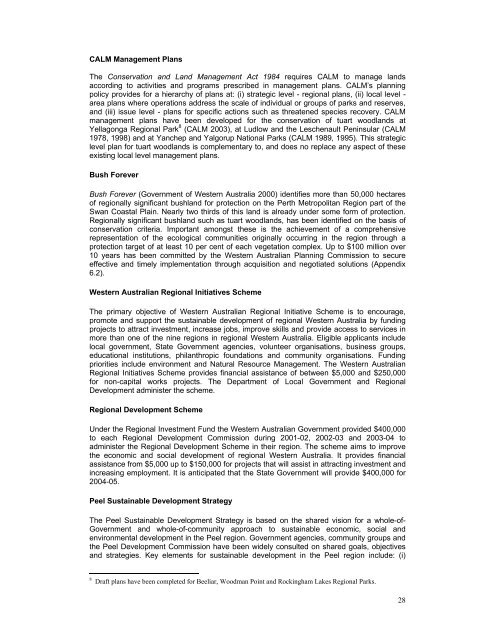DRAFT Tuart Conservation and Management Strategy
DRAFT Tuart Conservation and Management Strategy
DRAFT Tuart Conservation and Management Strategy
Create successful ePaper yourself
Turn your PDF publications into a flip-book with our unique Google optimized e-Paper software.
CALM <strong>Management</strong> Plans<br />
The <strong>Conservation</strong> <strong>and</strong> L<strong>and</strong> <strong>Management</strong> Act 1984 requires CALM to manage l<strong>and</strong>s<br />
according to activities <strong>and</strong> programs prescribed in management plans. CALM’s planning<br />
policy provides for a hierarchy of plans at: (i) strategic level - regional plans, (ii) local level -<br />
area plans where operations address the scale of individual or groups of parks <strong>and</strong> reserves,<br />
<strong>and</strong> (iii) issue level - plans for specific actions such as threatened species recovery. CALM<br />
management plans have been developed for the conservation of tuart woodl<strong>and</strong>s at<br />
Yellagonga Regional Park 8 (CALM 2003), at Ludlow <strong>and</strong> the Leschenault Peninsular (CALM<br />
1978, 1998) <strong>and</strong> at Yanchep <strong>and</strong> Yalgorup National Parks (CALM 1989, 1995). This strategic<br />
level plan for tuart woodl<strong>and</strong>s is complementary to, <strong>and</strong> does no replace any aspect of these<br />
existing local level management plans.<br />
Bush Forever<br />
Bush Forever (Government of Western Australia 2000) identifies more than 50,000 hectares<br />
of regionally significant bushl<strong>and</strong> for protection on the Perth Metropolitan Region part of the<br />
Swan Coastal Plain. Nearly two thirds of this l<strong>and</strong> is already under some form of protection.<br />
Regionally significant bushl<strong>and</strong> such as tuart woodl<strong>and</strong>s, has been identified on the basis of<br />
conservation criteria. Important amongst these is the achievement of a comprehensive<br />
representation of the ecological communities originally occurring in the region through a<br />
protection target of at least 10 per cent of each vegetation complex. Up to $100 million over<br />
10 years has been committed by the Western Australian Planning Commission to secure<br />
effective <strong>and</strong> timely implementation through acquisition <strong>and</strong> negotiated solutions (Appendix<br />
6.2).<br />
Western Australian Regional Initiatives Scheme<br />
The primary objective of Western Australian Regional Initiative Scheme is to encourage,<br />
promote <strong>and</strong> support the sustainable development of regional Western Australia by funding<br />
projects to attract investment, increase jobs, improve skills <strong>and</strong> provide access to services in<br />
more than one of the nine regions in regional Western Australia. Eligible applicants include<br />
local government, State Government agencies, volunteer organisations, business groups,<br />
educational institutions, philanthropic foundations <strong>and</strong> community organisations. Funding<br />
priorities include environment <strong>and</strong> Natural Resource <strong>Management</strong>. The Western Australian<br />
Regional Initiatives Scheme provides financial assistance of between $5,000 <strong>and</strong> $250,000<br />
for non-capital works projects. The Department of Local Government <strong>and</strong> Regional<br />
Development administer the scheme.<br />
Regional Development Scheme<br />
Under the Regional Investment Fund the Western Australian Government provided $400,000<br />
to each Regional Development Commission during 2001-02, 2002-03 <strong>and</strong> 2003-04 to<br />
administer the Regional Development Scheme in their region. The scheme aims to improve<br />
the economic <strong>and</strong> social development of regional Western Australia. It provides financial<br />
assistance from $5,000 up to $150,000 for projects that will assist in attracting investment <strong>and</strong><br />
increasing employment. It is anticipated that the State Government will provide $400,000 for<br />
2004-05.<br />
Peel Sustainable Development <strong>Strategy</strong><br />
The Peel Sustainable Development <strong>Strategy</strong> is based on the shared vision for a whole-of-<br />
Government <strong>and</strong> whole-of-community approach to sustainable economic, social <strong>and</strong><br />
environmental development in the Peel region. Government agencies, community groups <strong>and</strong><br />
the Peel Development Commission have been widely consulted on shared goals, objectives<br />
<strong>and</strong> strategies. Key elements for sustainable development in the Peel region include: (i)<br />
8 Draft plans have been completed for Beeliar, Woodman Point <strong>and</strong> Rockingham Lakes Regional Parks.<br />
28

















